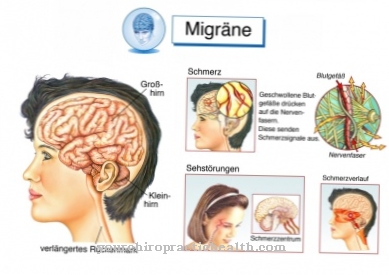In the Melorheostosis Bones of the extremities thicken in whole or in part without the patient noticing. Muscle edema, stunted growth or restricted mobility are only found in rare cases. Symptomatic therapy is limited to patients with actual symptoms.
What is melorheostosis?

© rost9 - stock.adobe.com
Diseases with specified changes in bone density or structure are a broad group that includes many individual diseases and can show a wide variety of clinical manifestations. One such manifestation is Melorheostosis. The disease is also called Léri syndrome known and was first described in the 20th century.
The Parisian neurologist André Léri is considered to be the first to describe it, and in honor of him the term Léri syndrome was introduced. Melorheostosis manifests itself in thickening of the skeleton, which is mostly in the extremities. The syndrome is sometimes referred to as mesenchymal dysplasia and is thus associated with anomalies in the embryonic mesenchymal tissue.
The manifestation can take place at any age. With a prevalence of less than one case in 1,000,000 people, melorheostosis is an extremely rare condition. The clinical terms Candle wax disease and Wax Bone Disease are often used synonymously with melorheostosis and describe the structural bone changes figuratively.
causes
The wax bone disease probably occurs sporadically. Family clusters have not yet been observed. An inheritance could therefore not be identified so far and is not considered applicable on the basis of the previous cases. Nevertheless, the disease seems to be based on genetic factors that lead to structural changes and impaired function of the bone tissue.
It was only in the recent past that bone changes were associated with a specific gene for the first time. Medicine currently suspects a mutation in the LEMD3 / MAN1 gene to be the cause of the disease. In the DNA, this gene encodes protein elements in the inner nuclear membrane. This is the inner part of the double-layer membrane, as it encloses the interior of cell nuclei and controls the transport of substances between the plasma and the cytoplasm.
The mutations of the mentioned gene reduce the function of the nuclear membranes and thus make the exchange of substances between the nuclear plasma and the cytoplasm more difficult. It has not yet been clarified which factors cause the mutation. For example, exposure to toxins or malnutrition during pregnancy are possible.
Symptoms, ailments & signs
Although it is a congenital disorder, most patients with melorheostosis show no symptoms into late adulthood. They often remain asymptomatic for life and are diagnosed by chance. In other cases, the symptom complex manifests itself early on through dermal changes.
Fibrosis of the dermal tissue can develop on the skin over the changed bone structures. In addition, some patients show edema of the muscles over the affected bone regions, which is accompanied by thickening and impairment of the muscles, tendons or joints. In particular, joints that are affected in this way sometimes cause pain or involuntary contractures of the muscles.
Patients with melorheostosis show growth disorders somewhat less often because the changes in the bones, for example, bridge the growth plates. All changes in melorheostosis occur preferentially on the limbs. Only in absolutely exceptional cases do dermal and skeletal symptoms of the disease manifest themselves in other locations. Some patients also notice differences in length or deformation of the extremities symptomatically.
Diagnosis & course of disease
Since melorheostosis usually remains symptom-free, it rarely takes its patients to the doctor. In most cases, the disease is recognized as an incidental finding in the X-ray image, for example in the case of X-rays as part of a broken bone or accident. The x-ray shows dermatom-like and striped sclerotization and condensation, reminiscent of wax droplets flowing off.
Radiologically, the doctor must rule out diseases such as osteomyelitis, osteopetrosis, osteopoikilia or Buschke-Ollendorff syndrome and scleroderma. This exclusion can take place, for example, by means of molecular genetic analysis. If there is evidence of mutations in the LEMD3 / MAN1 gene, the diagnosis of melorheostosis is considered confirmed.
Complications
Melorheostosis does not always lead to complaints or complications. In many cases, melorheostosis does not cause symptoms, so those affected live with the disease for life. Even with an accidental diagnosis, treatment does not have to be initiated in every case if those affected do not complain of complaints.
Furthermore, the melorheostosis can lead to distortions in the skin or bones. As a result, the muscles and joints in particular are negatively affected, which can lead to disturbances in the patient's movement. This also significantly restricts everyday life. In children, melorheostosis can lead to disorders of growth and thus to developmental disorders.
This often results in deformations of the extremities or different lengths of the extremities. However, the life expectancy of the patient is not reduced by this disease. The symptoms of melorheostosis can be well limited by various therapies and therapeutic measures.
In some cases, however, those affected have to live with the restricted mobility their entire life. In general, it cannot be predicted whether the disease will progress positively.
When should you go to the doctor?
In melorheostosis, symptoms do not appear in many patients until late adulthood. Since the disease is characterized by a lack of symptoms for a long time, there are no signs or warning signals for those affected that make a doctor's visit necessary. If the congenital disease shows the first signs of motor impairment, a doctor is required. If the person concerned suffers from a decrease in muscle strength, internal weakness or swelling near the bones, a doctor should be consulted. If the arms and legs cannot be stretched or bent as usual, there is cause for concern.
In the case of general movement restrictions or irregularities in movement sequences, a doctor must be reported about the observations. If there is pain in the bones, joints or tendons, the cause should be clarified. The formation of edema or disorders of the voluntary contraction of the muscles should be examined and treated.
If the general risk of accidents and injuries increases as a result of the complaints, everyday life should be restructured. A treatment plan is worked out together with a doctor. In addition, the person concerned receives important information about prevention and necessary measures when they visit a doctor. Deformations of the bones, abnormalities in the skeletal system and differences in length of the extremities must be examined by a doctor.
Treatment & Therapy
No causal therapy methods are currently available for patients with melorheostosis. The disease is currently still considered incurable. Gene therapy approaches are currently being researched as causal therapeutic steps in genetically determined diseases, but they have not yet reached the clinical phase. Genetic diseases such as melorheostosis can therefore only be treated symptomatically at the present time.
With melorheostosis the question arises as to the benefit of such a therapy. Since most patients remain symptom-free for the rest of their lives, in most cases no treatment is required. However, if symptoms are present, various treatment options are available. Restrictions of movement and growth disorders, for example, are often treated with the use of contractures and bone braces.
The dermal symptoms and fibroses of the skin do not necessarily have to be treated. In most cases, they do not affect the patient further and almost never develop into serious phenomena. As long as the proliferation of connective tissue does not bother the patient, therapy is usually not applied. Symptoms such as edema of the muscles, on the other hand, should be treated very well. This treatment is always a drug therapy and can, for example, correspond to the administration of diuretics.
Outlook & forecast
The disease melorheostosis has so far been considered incurable. Genetic causes presumably cause the malformation of the bones. In most cases, there is still a positive prognosis for the sick. You will remain symptom-free throughout your life. The problems turn out to be minor. Some scholars believe that the typical signs rarely appear after the age of 20. This means that boys and girls in the developmental stage are considered to be a risk group.
If symptoms arise, they can usually be successfully resolved through physiotherapy or surgical intervention. Doctors only perform an amputation in exceptional cases. Melorheostosis does not shorten the lifespan. However, patients may have to cope with slight or severe restricted mobility. This means that professional and private goals cannot always be fully realized. Psychological stress can occur.
If there is no therapy, there are usually no disadvantages. This is due to the fact that the majority of those affected notice little or no symptoms. However, if complications arise, medical treatment is indicated. Rejecting such offers of help can encourage an inability to move.
prevention
The triggering factors for a mutation in the LEMD3 / MAN1 gene are not yet known: even the mutation itself has only recently been linked to the disease. As long as the causal factors are not established, melorheostosis cannot be prevented.
Aftercare
Since melorheostosis has so far been considered incurable, follow-up care focuses on stabilizing the quality of life. Sometimes those affected remain symptom-free for the rest of their lives. The problems turn out to be minor. Some scholars believe that the typical signs rarely appear after the age of 20. This means that boys and girls in the developmental stage are considered to be a risk group.
In general, those affected and their relatives are advised to lead a healthy lifestyle with a balanced diet to support the immune system. He will also suggest certain relaxation and mental techniques for stabilization and advise on as many leisure activities as possible, which should give the affected family many nice hours together.
If the parents who have already been affected wish to have children again, a detailed genetic examination is recommended to determine the likelihood of another sick child in advance.
You can do that yourself
In addition to medical therapy, those affected can alleviate the symptoms of melorheostosis with a few measures and home remedies.
First of all, general tips such as taking care of yourself and avoiding stress apply. Since stunted growth and restricted mobility are often associated with poor well-being, appropriate countermeasures should be taken. This can be a fulfilling hobby, but also a healthy diet, exercise or a chat with friends. Which strategies make sense in detail is best determined together with a therapist. In general, melorheostosis patients should always consult a psychologist who can give further tips on how to deal with the psychological complications of the bone disease.
The physical symptoms can be treated with the help of natural preparations. Pain can be relieved with natural remedies such as the anti-inflammatory devil's claw or the soothing willow bark. Arnica and corresponding preparations from homeopathy help with severe pain. In the case of edema, the affected area should be cooled and stored upwards. Sometimes compression stockings also help, which should be custom-made if possible and must be worn consistently. Herbal extracts from the red vine leaves or horse chestnut seeds help reduce water retention. Likewise aescrin, rutoside and butcher's broom root.

.jpg)

























